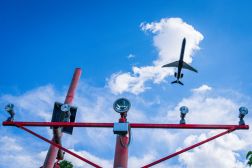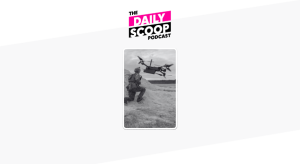FAA issues proposed rules for small drone integration

(iStockphoto)
After months of delays, the Federal Aviation Administration pushed out its framework of regulations Sunday for how it plans to integrate nonrecreational small unmanned aircraft systems into the national airspace.
The new rules offer safety regulations for drones weighing less than 55 pounds. According to the rule, UAS operators would only be able to operate their craft within the line of sight and only during the daylight hours.To be FAA-certified, drone operators would need to be older than 17, pass an aeronautical knowledge test and obtain a certificate from the FAA authorizing them to fly. Operators would need to retake the tests every two years.
“Today’s proposed rule is a big step forward in outlining the framework” for UAS integration, FAA Administrator Michael Huerta said on a Sunday press call. “This proposed rule offers a very flexible framework, while also accommodating future innovation in the industry.”

FAA Administrator Michael Huerta (FedScoop)
In lieu of requiring a small UAS to have detect-and-avoid technology, which most drones on the market don’t have, the proposed rule would require users to operate their devices within their line of sight. According to the proposed rule, a drone operator is responsible for navigating his or her craft away from another manned aircraft if there is a risk of collision.
The rule also would restrict flying drones over people other than those operating the flight. This would prohibit drones from being used at sporting events or for some breaking news situations.
Under the rules, drones would be able to fly no faster than 100 miles per hour and no higher than 500 feet. Operators would also be required to stay out of any airport flight paths and adhere to any FAA-sanctioned flight restriction areas.
“From entertainment to energy to agriculture, there are a host of industries interested in using UAS for their business, but for us at DOT, the first threshold must always be keeping the American people safe,” Transportation Department Secretary Anthony Foxx said in the Sunday press call. “The rule addresses two basic safety issues: One, keeping unmanned aircraft well clear of other aircraft and two, mitigating any risk for people on the ground.”
Though the FAA’s authority to regulate model aircraft-style drones was reaffirmed in last year’s Pirker ruling, the notice of proposed rulemaking does not affect hobbyist use of drones. The agency did, however, ask for the public’s input on creating a more flexible framework for “micro” drones, which weigh less than 4.4 pounds.
The notice of proposed rulemaking is not yet a rule — in fact, it must go through several stages before it is officially rolled out. The first of which is a posting on Regulations.gov, which will open the rules up for public comment. The comment period will last for 60 days from when the notice is posted in the Federal Register. The FAA has also said it will host a series of public meetings to discuss innovation and opportunities at the FAA-sanctioned UAS test sites and at the FAA-established UAS Center of Excellence.
The U.S. is hardly alone in trying to promote innovative uses of UAS. The United Arab Emirates last week awarded a $1 million prize, the largest of its kind for the development of drones for public service applications.
For now, until the FAA rule is established, any users wishing to use drones for nonrecreational purposes are still required to apply for an exemption or a certificate of authorization with the FAA to allow them to use their devices. The FAA has already released more than two dozen commercial exemptions for UAS operation, according to Huerta.
“Safety is always our No. 1 priority, this proposed rule makes sure that we are protecting other aircraft as well as people on the ground,” Huerta said.
On the same day the proposed rule was released to the public, the White House released a memorandum to executive agencies, handing over privacy regulations for drones to the National Telecommunications and Information Administration.
“As UAS are integrated into the NAS, the Federal Government will take steps to ensure that the integration takes into account not only our economic competitiveness and public safety, but also the privacy, civil rights, and civil liberties concerns these systems may raise,” Obama said in the memorandum.
In addition to delegating authority, the executive memorandum also establishes privacy guidelines for federal agencies using drones. According to the memorandum, agencies are only allowed to collect information using UAS when the collection is consistent with an authorized purpose, such as a warrant or other public agency authorization.
The data collected by agencies using UAS may not be retained for more than 180 days, unless the information is deemed necessary by the agency and is maintained properly. That same data cannot be dispersed outside of the agency.
The memorandum looks at the potential constitutional ramifications, as well. It tasks agencies with ensuring that civil rights and liberties are protected, and that policies are in place to prohibit any collection of data that could violate the First Amendment or potentially discriminate against people.
The White House’s privacy restrictions for UAS come as several states across the country are looking into addressing that very issue with legislation. So far, Oklahoma, Virginia and, most recently, in Florida, have addressed UAS privacy, specifically requiring a warrant for the use of UAS by public agencies to collect information.
By mid-August, agencies are required to send to the White House a status report on their progress with the privacy requirements it establishes. By February 2016, the agencies will need to publish information on how the public can access their policies and procedures for UAS privacy.
Under the Commerce Department, the NTIA will develop a “multi-stakeholder engagement process” to develop a drone privacy framework to address the accountability and transparency aspects of commercial and other nonrecreational UAS operation. That engagement process, however, will not include government and law enforcement considerations.
The FAA’s drone rules are scheduled to be put in place by the end of 2015, according to the 2012 FAA Modernization and Reauthorization Act. However, the FAA’s inspector general has said that the agency will miss that deadline.






